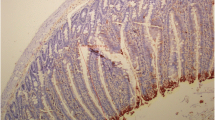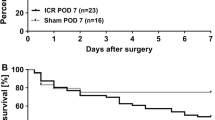Simulation of short bowel syndrome (SBS) in experimental animals is of great interest for studies in translational medicine. The processes of intestinal adaptation are most often studied in rats aged 8-10 weeks with up to 70% resection the small bowel. In this case, the animals are euthanized in 2 weeks after the surgery; further development of the pathological process remains practically unexplored. In our experiment, a number of blood biochemical parameters and morphological signs of intestinal adaptation were assessed within 34 weeks after surgery. It was shown that after resection of 70% of the small bowel in rats (180±15 g), clinical symptoms are observed only during the first 2 weeks, however, the mortality in the group was observed throughout the entire period of the study in the absence of clear clinical signs. Morphological compensatory changes in the walls of the small intestine continued up to 34 weeks after resection, and their morphometry can be used to describe adaptation in the dynamics of the study.
Similar content being viewed by others
References
Kosulin AV, Beldiman LN, Kromsky SV, Kokorina AA, Mikhailova EV, Sokolova MO, Kriventsov AV, Aleksandrov VN. Tissue engineering for compensating short bowel syndrome. Vestn. Ross. Voen.-Med. Akad. 2018;(2):259-264. Russian.
Oynotkinova OS, Nikonov EL, Demidova TY, Baranov AP, Kryukov EV, Dedov EI, Karavashkina EA. Changes in the intestinal microbiota as a risk factor for dyslipidemia, atherosclerosis and the role of probiotics in their prevention. Ter. Arkhiv. 2020;92(9):94-101. doi: https://doi.org/10.26442/00403660.2020.09.000784.Russian.
Billiauws L, Thomas M, Le Beyec-Le Bihan J, Joly F. Intestinal adaptation in short bowel syndrome. What is new? Nutr. Hosp. 2018;35(3):731-737. doi: https://doi.org/10.20960/nh.1952
Buccigrossi V, Armellino C, Tozzi A, Nicastro E, Esposito C, Alicchio F, Cozzolino S, Guarino A. Time- and segmentrelated changes of postresected intestine: a 4-dimensional model of intestinal adaptation. J. Pediatr. Gastroenterol. Nutr. 2013;56(1):40-45. doi: https://doi.org/10.1097/MPG.0b013e318268a9a4
Chandra R, Kesavan A. Current treatment paradigms in pediatric short bowel syndrome. Clin. J. Gastroenterol. 2018;11(2):103-112. doi: https://doi.org/10.1007/s12328-017-0811-7
Gabriel FR, Suen VM, Marchini JS, Dutra de Oliveira JE. Ingestion of ferrous sulfate increases ferremia in patients with short bowel syndrome. Nutrition. 2009;25(11-12):1115-1119. doi: https://doi.org/10.1016/j.nut.2009.01.019
Martin LY, Ladd MR, Werts A, Sodhi CP, March JC, Hackam DJ. Tissue engineering for the treatment of short bowel syndrome in children. Pediatr. Res. 2018;83(1-2):249-257. doi: https://doi.org/10.1038/pr.2017.234
O’Keefe SJ, Buchman AL, Fishbein TM, Jeejeebhoy KN, Jeppesen PB, Shaffer J. Short bowel syndrome and intestinal failure: consensus definitions and overview. Clin. Gastroenterol. Hepatol. 2006;4(1):6-10. doi: https://doi.org/10.1016/j.cgh.2005.10.002
Sangild PT, Ney DM, Sigalet DL, Vegge A, Burrin D. Animal models of gastrointestinal and liver diseases. Animal models of infant short bowel syndrome: translational relevance and challenges. Am. J. Physiol. Gastrointest. Liver Physiol. 2014;307(12):G1147-G1168. doi: https://doi.org/10.1152/ajpgi.00088.2014
Sukhotnik I, Siplovich L, Krausz MM, Shiloni E. Peptide growth factors and intestinal adaptation in short bowel syndrome. Isr. Med. Assoc. J. 2003;5(3):184-187.
Tappenden KA, Edelman J, Joelsson B. Teduglutide enhances structural adaptation of the small intestinal mucosa in patients with short bowel syndrome. J. Clin. Gastroenterol. 2013;47(7):602-607. doi: https://doi.org/10.1097/MCG.0b013e3182828f57
Author information
Authors and Affiliations
Corresponding author
Additional information
Translated from Byulleten’ Eksperimental’noi Biologii i Meditsiny, Vol. 172, No. 12, pp. 785-791, December, 2021
Rights and permissions
About this article
Cite this article
Kokorina, А.A., Mikhailova, E.V., Krylova, S.A. et al. A Model of Short Bowel Syndrome in Rodents in a Long-Term Experiment. Bull Exp Biol Med 172, 779–784 (2022). https://doi.org/10.1007/s10517-022-05477-4
Received:
Published:
Issue Date:
DOI: https://doi.org/10.1007/s10517-022-05477-4




